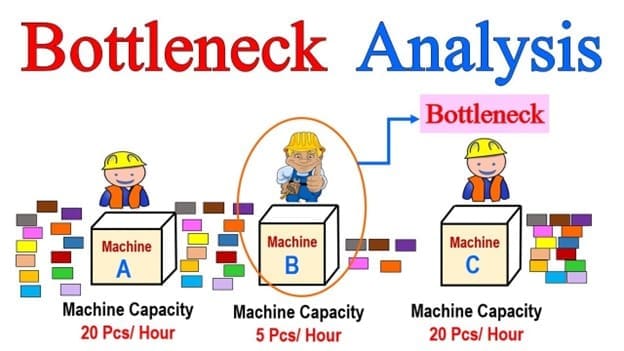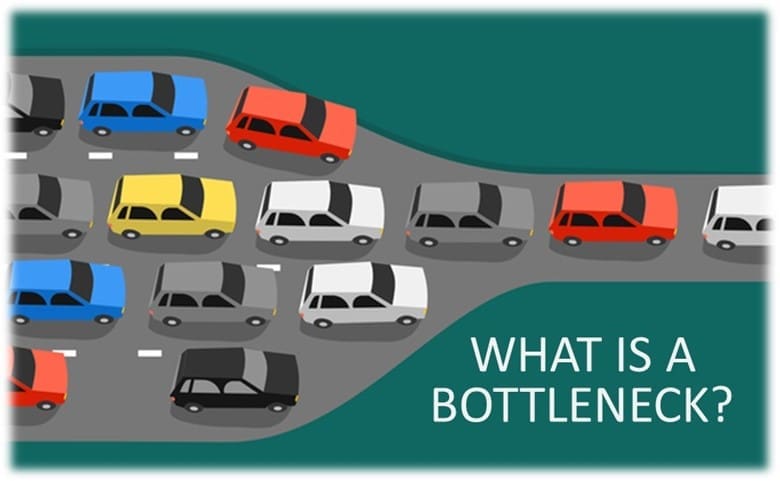Table of contents
- What is a bottleneck?
- Production Variations
- Production Capacity
- How do you detect a workflow bottleneck?
- How do you reduce or eliminate bottleneck effects?
- Short-term and long-term bottleneck effects
- What can we achieve by analyzing bottlenecks?
- What to look for in a bottleneck analysis
- Bottleneck Analysis tools
- In conclusion
- Related Articles
What is a bottleneck?
When workloads are too large or too fast for the production line to handle, a bottleneck can become an issue. Inefficiencies caused by this backup can lead to delays and higher production costs. The bottleneck refers to the shape and size of the bottle. It is also the place where the bottle is most likely to become congested. This slows down the liquid flow.
Delays in manufacturing can lead to a dramatic increase in production costs and time. When a company starts the production process of a new product, they are more vulnerable to bottlenecks. Because there could be problems in the production process that the company needs to fix, this situation will require more scrutiny and fine-tuning. Operations management focuses on controlling production, identifying bottleneck effects early, and finding effective solutions.
Production Variations
A variance is a difference in production results between the budgeted and actual results. Managers examine variances to adjust and eventually eliminate bottlenecks. Managers may find that labor costs are higher than expected and decide to make changes. Labor costs can be decreased if management can eliminate the bottleneck.
If materials are left on the factory floor, waiting to be used, a bottleneck could also lead to material variance. You can solve bottlenecks by increasing capacity utilization and finding new suppliers.
Production Capacity
A bottleneck can affect the production capability that a company can achieve each month. Theoretical capacity is the ability of a company to always produce at its maximum capacity. This assumes that there are no machine breakdowns, breaks in the bathroom, or vacations for employees.
Businesses use their practical capacity to manage production because theoretical capacity is unrealistic. This capacity includes downtime for machine repairs as well as employee time off. Practical capacity is the range of processes that can be operated efficiently without crashing. If you go beyond the optimal range, the possibility of a bottleneck caused by a breakdown in one or more processes increases. There are many options available to a company if its production capacity is not sufficient to meet its production goals. Management could choose to reduce their production goals to make them more in line with their production capabilities. They could also work together to find ways to simultaneously reduce production bottlenecks and increase production. To meet their production goals, companies often use capacity requirement planning tools and methods.

How do you detect a workflow bottleneck?
If your workflow is chaotic and unpredictable, it’s likely that you don’t have smooth-flowing operations.
It is important to pinpoint the problem and set a countermeasure. You can use several analysis tools to identify bottleneck effects in LEAN Management.
In just three steps, you can identify a bottleneck.
- Visualize. Tracking your work makes it easy to see which work items are getting piled up. This is usually a sign that there is a problem or bottleneck.
- Map Queues & Activities. By separating activities from queues and mapping them we can see how long our work is sitting in a queue before a specific activity. You have identified your bottleneck if the queue grows faster than the activity stages processes.
- Measure the Cycle Time Per Stage. By measuring the cycle time at each stage, you can create a heat map diagram of the cycle time. These workflow stages could also be called queues.
How do you reduce or eliminate bottleneck effects?
Work in batches
Some operations will take less time if similar work items are organized in batches. Be cautious. Higher risk is associated with larger batches. A smaller batch is better. However, in real life, sometimes we must compromise.
Increase the number of people and resources
To speed up the process, you should increase the capacity at the bottleneck. Keep your eyes open. Once the system’s resources have been re-distributed, another bottleneck will appear.
Set WIP limits
Consider setting a WIP limit if it does not exist.
Do not leave the bottleneck idle
The ripple effect of flow should be considered. Always load the bottleneck at its maximum capacity.
Work to Reduce the bottleneck
Ensure that the work is delivered in the best possible form. If the review process becomes a bottleneck, make sure that quality is maintained from the beginning. You must ensure that the work being reviewed is flawless. Every error the reviewer discovers is going to cost more time and money.
Short-term and long-term bottleneck effects
Short-term
Short-term bottlenecks can be caused by an operator’s absence or delay in receiving materials from another vendor because of one-off shipping issues.
Long-term
These are problems that recur and have a significant impact on manufacturing processes. Some examples include:
- There is no real-time data to identify patterns within the production
- An inadequate material tracking system results in a lack of traceability
- Delay in production due to audit procedures and paper-based work instructions
While short-term bottlenecks can be isolated and do not require regular attention, long-term bottlenecks will need to be addressed.

What can we achieve by analyzing bottlenecks?
- Look for solutions to the bottlenecks
- Identify and fix the bottlenecks in your production and management processes
- Collect relevant quantitative data for bottleneck analysis
- Reduce mediocre quality products, improve worker efficiency, and reduce downtime
- Increase production capacity and reduce lead times
What to look for in a bottleneck analysis
The bottleneck will be the one with the longest queue. These red flags can be used to determine if a target step is causing a blockage in the overall workflow.
Accumulation
An accumulation occurs when the input exceeds what a machine can handle. Because the work order can’t be processed at the same speed as other steps in manufacturing, inventory and work hours can build up.
Full capacity
The bottleneck in the production process will be a unit or machine that is using most of its full potential. This is easily compared with the lower capacity utilization rates of other units on the shop floor. The bottleneck unit will stop working if the input is increased.
Slow communication
Is there any miscommunication? Or slow communication that could lead to slower manufacturing processes? Low physical products can be caused by poor communication at all levels.
Throughput and throughput times
Each machine’s throughput can be increased individually to determine which one has the greatest impact on overall production output. A longer-than-average throughput could also lead to delays in inspection and move times, as well as an increase in the waiting time. It may be necessary to investigate further to determine which step is taking too long.
Bottleneck Analysis tools
Theory of constraints (TOC)
A method to find the constraint, test it and improve it.
- Identify the problem: Look again for signs or speak with the person who raised it. People closest to the problem will be able to provide information and offer solutions.
- Use the constraint: Do not let it stop. This will make it easier to see the effects and keep them consistent. This step should not take too long.
- All other steps must be subordinated to the constraint. Let the Takt time of the constraint determine the rest. You will need to observe what else must be changed to match the Takt time, and then evaluate the implications for the rest.
- Lift the constraint: In this instance, “elevate” means to improve the process around the constraint or bottleneck. To reduce mistakes, do this as fast as possible.
- Continue the TOC process. Making changes at one stage of the process can cause a bottleneck at the next. Be prepared to continue this process until you have improved the entire line. Clear communication channels between the project team and the other operators can help streamline the process of identifying and implementing improvements. This can help everyone to see the effects of any bottlenecks or improvements. Communication is the key to reducing frustrations and spreading rumors.
Lean Six Sigma DMAIC Process
This five-step methodology uses data to improve a process.
- Define the project.
- Measure process activities, effects, and ability to meet established specifications.
- Use the data you have collected to identify the root cause. (Helpful tools are Root Cause Analysis and Failure Mode Analysis and Effects or a Multivariable chart).
- Find ways to eliminate the root cause by improving the process. (Helpful tools are Design for Experiments and Kaizen Events)
- Control and monitor performance using tools such as 5S and Poke-yokes.
In conclusion
It is not enough to find the bottleneck, it is crucial. It is more likely that you will find it sooner than expected if you have created an environment where trust and genuine interest in improvement are present. After the improvements have been made, it is important to acknowledge the people responsible for them and those who support them or make improvements.












